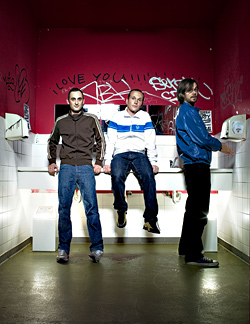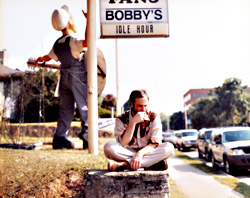Singers, songwriters, and guitarists Ken Stringfellow and Jon Auer met at a Bellingham music store as teenagers in the mid-’80s. They began the Posies in 1988 with bassist Rick Roberts and drummer Mike Musburger, both of whom left by the mid-’90s, playing sweet-toned pop-rock that, along with similar fare from Teenage Fanclub and Matthew Sweet, became early ’90s college- radio favorites and recording five albums before splitting in 1998. They got back together two years later, and subsequent acoustic shows and brief tours have led to the new record, Every Kind of Light (Rykodisc). Recorded with bassist Matt Harris and drummer Darius Minwalla, who’ve worked with Stringfellow and Auer since 2001, Light is coolly sophisticated but features plenty of the hyperactive, British Invasion–inspired pop on which they’ve built a career. In the interim, Stringfellow and Auer have completed solo records and worked with R.E.M. and Big Star. The Jukebox took place in Stringfellow’s Seattle home (he splits his time between here and France) prior to the Posies’ Bumbershoot performance, and a few days before the national tour that winds up at Neumo’s and the Wild Buffalo this week.
The dB’s: “Black and White” (1981) from Stands for Decibels (IRS) and Flamin’ Groovies: “I Can’t Hide” (1976) from Shake Some Action (Sire)
Ken Stringfellow: [as dB’s play] Is this the song we left off Failure? [laughs] Is that the dB’s?
Jon Auer: It could be Mitch Easter– or Don Dixon–produced. It definitely has the Mitch Easter sound of the early R.E.M. recordings.
Stringfellow: [dB’s drummer] Will Rigby wanted to be in the Posies. [Flamin’ Groovies begins] Is that the Brian Jonestown Massacre? [laughs]
Seattle Weekly: Good guess.
Stringfellow: I think its Andrew W.K.
Auer: Or the new Glenn Danzig record. That sounds like Danzig, a little bit.
Stringfellow: Can I just ask if every song is the dB’s, through the end?
Auer: I will admit I’ve heard the dB’s, but I’ve never heard these songs before. So this is a first.
SW: This is the Flamin’ Groovies.
Both: Ah.
Auer: I have two or three Flamin’ Groovies records. I always gravitate toward “Teenage Head”—I think it’s one of the greatest rock songs ever. I like their nastier stuff, to be honest. Not to mention their note-for- note cover of [the Byrds’] “I’ll Feel a Whole Lot Better.”
SW: I chose both bands because they appear, along with the Posies, on the new Children of Nuggets compilation.
Auer: Of which we have yet to get copies!
Stringfellow: I’ve only read about it.
SW: I was hoping you’d talk about your part in—
Stringfellow: The dB’s reunion? [laughs]
SW: —the power-pop revival, which figures heavily into the compilation.
Auer: “Power pop,” even at this point, is a term that can rub us the wrong way, because sometimes it’s been limiting to us. It’s interesting to get lumped with certain bands, when legitimately some of our music falls into the power-pop category, but a lot of it doesn’t.
Stringfellow: Yes, it’s funny how that dB’s song bears quite a few similarities to Failure in terms of the dinky drums and acoustic guitar. Yes, there’s some relationship [to us]. Unfortunately, what we did then has determined the category we’re sent to for the rest of our lives. We were 17, it was 1988. That was a long time ago.
SW: Did bands like these make you want to start one?
Auer: I hadn’t heard those bands [at the time]. Flamin’ Groovies and dB’s were bands that friends of mine who were older and working in record stores . . .
Stringfellow: And still living at home . . .
Auer: . . . told me about after the fact, saying, “Wow, I really like your Failure record. . . . “
Stringfellow: [mocking] “Jon, my mom’s not gonna be home this week. Do you wanna come over late at night and listen to the dB’s?”
SW: Were you big record shoppers as well?
Stringfellow: In high school.
Auer: I worked in a record store and took lots of records. Cellophane Square was the main hub for both Ken and I. For some reason, I liked to buy and sell records. I would buy one, sell it, and then Ken would buy it. I bought Hatful of Hollow by the Smiths on vinyl, for some reason went through a mood swing and decided I didn’t want it anymore. Ken must’ve been waiting in the wings and went right in and purchased it.
R.E.M.: “Talk About the Passion” (1983) from Murmur (IRS)
Auer: Never heard this.
Stringfellow: No comment.
SW: How did you get involved with R.E.M.?
Stringfellow: I can tell you this much—we covered one of their songs in our very first show in ’87.
Auer: “Sitting Still,” right?
Stringfellow: Yeah. It was an acoustic show, just the two of us. Jon and I were fans of the Young Fresh Fellows and got to know Scott McCaughey around the time we started playing in a band in 1988. Scott befriended [R.E.M. guitarist] Peter Buck, staying at his house on tour with the Fellows. Scott started playing with them, and then Jon, Scott, Peter, and I played in the Minus Five. Like how Mercedes and Chrysler are owned by the same company, I ended up playing with R.E.M. through that stock exchange.
Auer: I think you might’ve bought me Fables of the Reconstruction for my 16th birthday.
Stringfellow: Oh yeah, because I have it now.
Auer: Exactly [laughs], because I sold it a couple days later.
SW: What brought you back to working together?
Auer: I’ve got all this vinyl I wanted to get rid of.
Stringfellow: Well, they say comedy is tragedy plus time—that about says it all. We’ve been good friends since high school. Doing music is like being drafted with friends and sent to Guadalcanal; it’s either going to be the world’s greatest bonding experience or something ugly is going to come out of it—some tale you only tell your grandchildren when you’re really drunk.
Auer: A bit of both, really. Around 1998, it reached the point where we didn’t want to honor our friendship anymore.
Stringfellow: It’s hard when the last thing you want is to be in the same room. But you have to be in the same room every day.
SW: Were you recording and touring full time?
Auer: We took some long breaks, but we were always working at it. It seems like now we’re working more consistently than we did back then.
Stringfellow: I think we cruised along in dysfunction until—well, you can’t cruise along forever.
Auer: That’s a great way of putting it.
Stringfellow: The period I recall everything working for our band was [laughs] . . . the period I recall everything not working started around 1995. Amazingly enough, we continued to work on Amazing Disgrace and toured extensively when it came out in 1996. Just to put things into perspective, there was a bit of fun at the beginning and then figuring out how to do what we do, and then when we started to get better as musicians, some personal issues caught up and derailed everything. I keep wanting to make clear in these interviews that, yeah, we split up for two years, and people think that’s not very long, but the period before that had some reality deficits.
Auer: Success [from 1998] was planned as our last record. We went into it very controlled, like, let’s get through this. And then we ended up doing one big European tour. To show you how bad it got, we had a U.S. tour planned, and typically we’re not a band to blow things off easily or not live up to responsibilities. But when we finished that tour, certain factions in the group said there’s absolutely no way we’re going to continue on the U.S. leg, and we blew it off. We let it all go because frankly, at that point, we didn’t care. At least some of us didn’t. That said, to many people, Every Kind of Light seems like a return after seven years, but really, Ken and I started playing together again around 2000. We’d worked on a box set and greatest-hits package. Going through boxes of archival photos and old demos forced us to take stock of our past.
SW: The new record sounds more soulful than your past work together. Is there a difference in production or songwriting?
Stringfellow: We wrote the songs mostly on the spot in the studio. It’s certainly different than the layer-by-layer approach used on most of our other records.
Auer: We also limited ourselves. We said perhaps certain things couldn’t be considered Posies material. Relating back to the power-pop label, a lot of my favorite records have nothing to do with that genre. So, arguably, it’s fun to expose some of those other influences. I’m not saying we’ve gotten anywhere close to a Shuggie Otis record or Marvin Gaye’s What’s Going On. Those are some of my favorite records, as opposed to what people might typically think I own.
Neil McArthur [aka Colin Blunstone]: “She’s Not There” (1969) from Collecting Peppermint Clouds (Technicolor Dream)
Stringfellow: [after heavy guitar intro] Is this the first Van Halen record? [vocal kicks in] A-ha!
Auer: Ah, yeah. I’m guessing it’s the Zombies and the Guess Who playing together, actually, by the sound of the guitar.
Stringfellow: This is a party at [the Animals’] Eric Burdon’s house. So this is a Colin Blunstone solo thing of some sort, from which album?
SW: It was a single recorded right after the Zombies broke up—Blunstone recorded it under the name Neil MacArthur. What did you listen to growing up?
Stringfellow: One thing that is crucial in understanding us is how unhip our upbringing was. We were not big-city kids, we were small-town kids—not a total excuse because Bellingham did have a good radio station and some cool record stores. But there’s also one more step that’s involved in finding out what’s happening in music in that community.
Auer: My rite of passage was a little different because of all these older men who worked in record stores with me. Those guys would make some of the best compilation tapes, particularly when they saw this young kid who had more interest in music history than contemporary music. I first heard [the Zombies’] Odessey & Oracle because it was given to me by someone who knew I liked the Beatles.
The Beach Boys: “In My Room (German Version)” (1964) from Surfer Girl/Shut Down Volume 2 (Capitol)
Auer: [hums along] Are they actually singing in German, “Mike Love is the world’s biggest asshole?”
SW: Ken, your solo record from last year, Soft Commands, has a Brian Wilson feel.
Stringfellow: It started out as a Phil Spector thing, which is where Brian Wilson was headed—hiring the same musicians and using the same studio as Spector, and adding these insane vocal effects. That was what made the Beach Boys sound early on. I started out making a Phil Spector piece of music and added some Beach Boys vocals, and then there was no Spector left.
SW: Jon, what can you tell us about your new solo record, The Year of Our Demise?
Auer: It’s something I worked on a long time, and made all by my lonesome—locked myself in a room, built the microphones, and did everything from the ground up. Funny, I’ve been working on it so long, people in the Posies camps and on fan lists started to dub it an “urban myth,” like it doesn’t really exist, but I can assure you it does and it’s coming out in March.
SW: Are you still writing material together?
Stringfellow: We’ve been trying to master our catalog and make these live shows a bit more diverse.
Auer: Some of us thought maybe on the road, when we have the chance, we’d write some new material.
SW: Have you been playing with the current lineup for a while?
Auer: It’s become that way. We’ve played a couple one-offs and a small tour together. Since 2001 it’s been the occasional show, but now it’s a full-time job—or full-time joy.
The Posies play Neumo’s with Oranger and the Village Green at 8 p.m. Thurs., Oct. 20, $8 adv./$10; and Wild Buffalo (208 W. Holly, Bellingham, 360-752-0848, with Wingman at 9 p.m. Fri., Oct. 21. $10 adv./$12.








